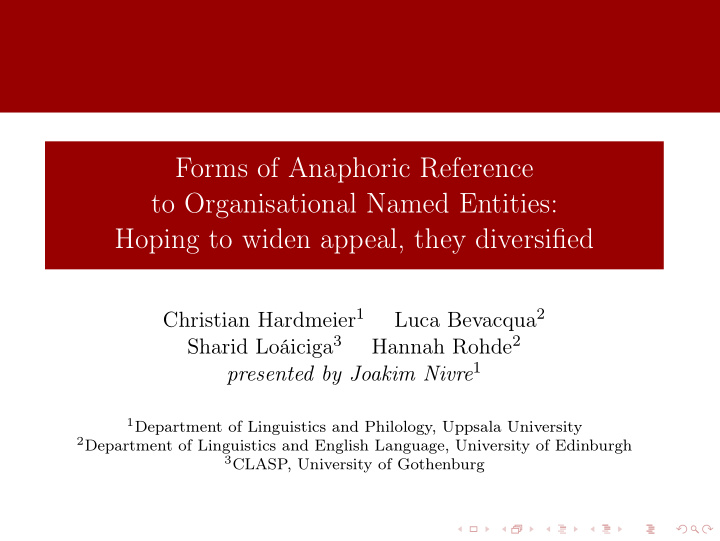



Forms of Anaphoric Reference to Organisational Named Entities: Hoping to widen appeal, they diversified Christian Hardmeier 1 Luca Bevacqua 2 Sharid Loáiciga 3 Hannah Rohde 2 presented by Joakim Nivre 1 1 Department of Linguistics and Philology, Uppsala University 2 Department of Linguistics and English Language, University of Edinburgh 3 CLASP, University of Gothenburg
Organisational Named Entities Names of organisations: Companies, political bodies, sport teams, music bands, etc. Often made-up words ( Intel , Novartis ) or acronyms ( EU , Unesco ) Little information about number or gender Different conceptualisation Singular: collective as a unit Plural: individuals within organisation
Names of Organisations as Collective Nouns Special case of collective nouns such as team , family , etc. Studied in English linguistics, especially for verb agreement Can be used with singulars ( syntactic agreement ) or plurals ( notional concord ) in English American English: often singular verbs but plural pronouns Singular and plural agreement can co-occur ( mixed concord )
Our Study Research question: What forms are possible and preferred when re-mentioning named entities? Current study on English – multilingual extension planned Two types of experiments: Corpus study on OntoNotes Story continuation experiments on Mechanical Turk
Four Types of References We consider four types of references to organisations: name noun it they Name: Repetition of the proper name Since the introduction of the first MacBook, Apple grew bigger and bigger. Last year, Apple sold the most MacBooks in its history.
Four Types of References We consider four types of references to organisations: name noun it they Noun: Paraphrastic noun phrases AC/DC achieved international success in 1976. In the next forty years, the band continued to attract more loyal fans.
Four Types of References We consider four types of references to organisations: name noun it they It: Pronoun with singular conceptualisation Since the introduction of the first MacBook, Apple grew bigger and bigger. Last year, it had record sales.
Four Types of References We consider four types of references to organisations: name noun it they They: Pronoun with plural conceptualisation Google entered the search machine business in 1998. Ten years later, they were still in business.
Example Extraction OntoNotes: ∼ 1.7 million words of American English text Gold-standard coreference and named entity annotations Subcorpora: bc broadcast conversation bn broadcast news magazines newswire mz nw tc telephone conversations wb web data Each example: a pair of mentions belonging to the same coreference chain occurring in adjacent sentences with no intervening mentions from the same chain
Reference Types per Genre
Reference types per genre it they name noun other total bc 8 15 59 10 13 105 bn 11 12 146 44 12 225 mz 17 11 91 24 4 147 nw 76 11 926 193 36 1242 tc 2 3 7 0 0 12 wb 6 4 52 8 4 74 120 56 1281 279 69 1805
Formality and Use of it Hypothesis: Singular conceptualisation is more likely in more formal text genres. Suggested for general collective nouns (Hundt, 2009) Measure: proportion of it among pronominal references: N ( it ) N ( it ) + N ( they )
Measuring Formality Metric of text formality (Heylighen & Dewaele, 2002) Assumption: Formality is reflected in the use of certain parts of speech. Formal vocabulary: nouns, adjectives, prepositions, articles Deictic vocabulary: pronouns, verbs, adverbs, interjections Score calculation: F = 100 · N formal − N deictic + 50 2 N
Formality and Use of it
Conclusions Correlation between formality and singular conceptualisation confirmed in OntoNotes. Rank correlation is significant ( ρ = 0 . 886; p < 0 . 05 ). Linear correlation is not ( r = 0 . 67; p = 0 . 146 ). Modality also seems to play a role: Strongest preference for they in the spoken subcorpora.
Continuation Experiments Two crowdsourcing experiments on Amazon Mechanical Turk Participants saw 16 target items + 48 fillers Each item was a pair of sentences: Sentence #1: introduced a named entity in subject position Sentence #2: adverbial prompt to elicit a reference to the named entity Instructions: complete sentence #2
Two Studies Study 1: Constructed stimuli 27 mturk participants (restricted to US IP addresses) Prompt sentences constructed by the authors Four types of named entities: Companies, publishers, sport teams and music bands Last week, Intel announced the shutdown of the factory. In the press release,
Two Studies Study 2: Corpus stimuli 19 mturk participants (same US IP address restriction) Prompt sentences extracted from OntoNotes and simplified Continuations constructed to increase chances of eliciting a reference to the named entity Generally longer and more complex than Study 1 stimuli Unrelated filler items likewise from corpus data To distinguish itself, CNN is also expanding international cov- erage and adding a second global-news program. At the annual press conference,
Continuation Studies: Results constructed corpus it 32 24 they 307 113 name 19 11 noun 12 16 total 370 164
All Results
Conclusions Very high proportion of they in continuation study. More varied responses with corpus stimuli, but they is still dominant. In OntoNotes, they use is negatively correlated with formality. Results of continuation study are more representative of informal and spoken language, even though the task was done in writing. Results will be used as a baseline in a multilingual experiment on English, German, French, Italian and Spanish.
Questions Further questions can be addressed to: Christian Hardmeier: christian.hardmeier@lingfil.uu.se Luca Bevacqua: lbevacqu@ed.ac.uk Sharid Loáiciga: sharid.loaiciga@gu.se Hannah Rohde: hannah.rohde@ed.ac.uk
Recommend
More recommend